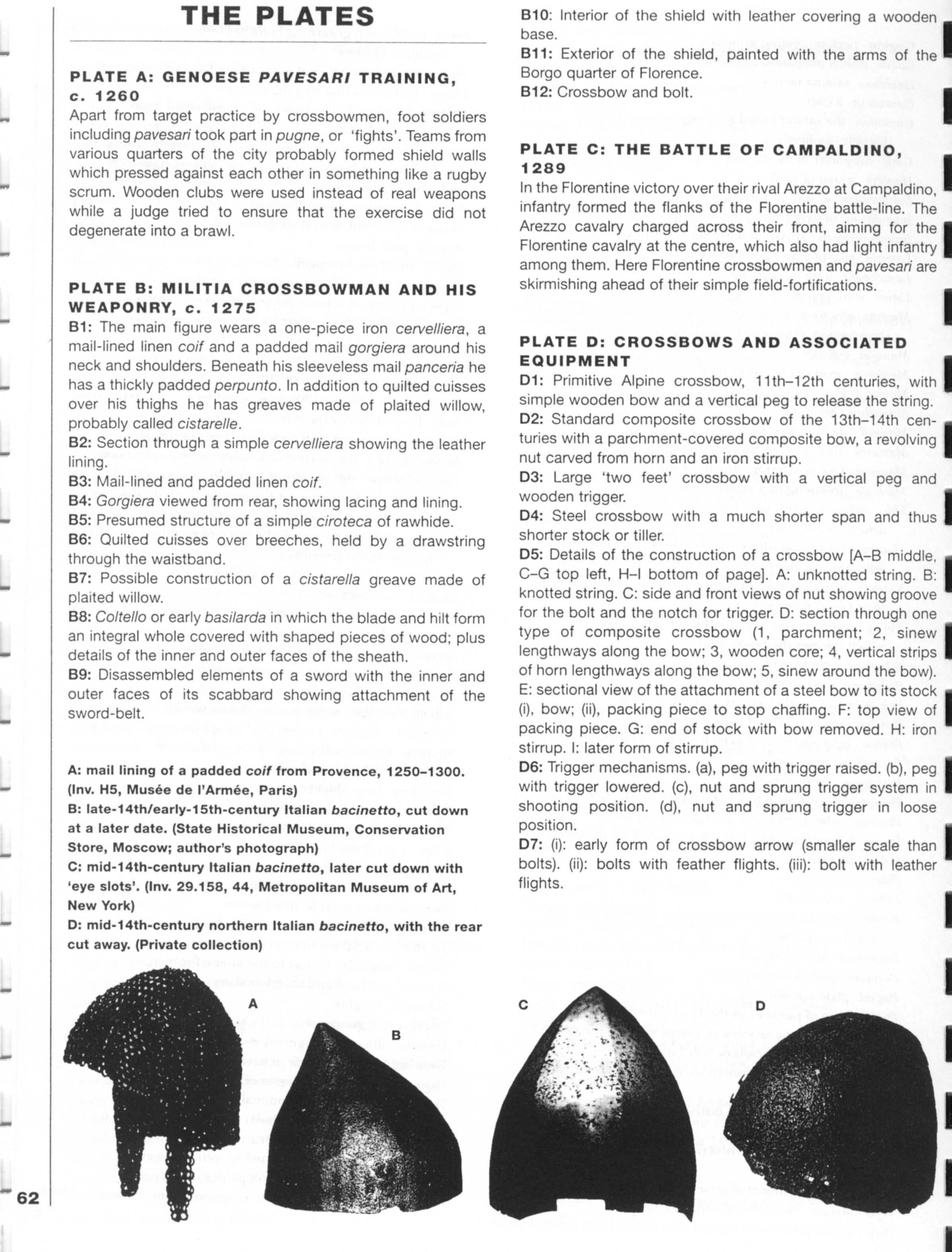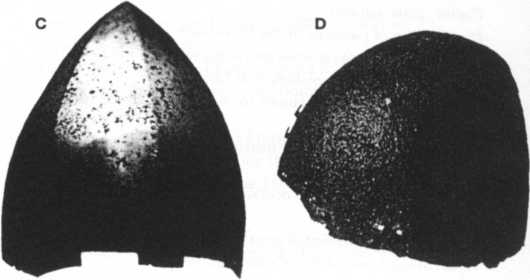w25b

THE PLATES
PLATĘ A: GENOESE PAVESARI TRAINING,
c. 1260
Apart from target practice by crossbowmen, foot soldiers including pavesari took part in pugne, or ‘fights’. Teams from various quarters of the city probably formed shield walls which pressed against each other in something like a rugby serum. Wooden clubs were used instead of real weapons while a judge tried to ensure that the exercise did not degenerate into a brawl.
PLATĘ B: MILITIA CROSSBOWMAN AND HIS WEAPONRY, c. 1275
B1: The main figurę wears a one-piece iron cervelliera, a mail-lined linen coif and a padded mail gorgiera around his neck and shoulders. Beneath his sleeveless mail panceria he has a thickly padded perpunto. In addition to quilted cuisses over his thighs he has greaves madę of plaited willow, probably called cistarelle.
B2: Section through a simple cervelliera showing the leather lining.
B3: Mail-lined and padded linen coif.
B4: Gorgiera viewed from rear, showing lacing and lining.
B5: Presumed structure of a simple ciroteca of rawhide.
B6: Ouilted cuisses over breeches, held by a drawstring through the waistband.
B7: Possible construction of a cistarella greave madę of plaited willow.
B8: Coltello or early basilarda in which the blade and hilt form an integral whole covered with shaped pieces of wood; plus details of the inner and outer faces of the sheath.
B9: Disassembled elements of a sword with the inner and outer faces of its scabbard showing attachment of the sword-belt.
A: mail lining of a padded coif from Provence, 1250-1300. (Inv. H5, Musee de l’Armee, Paris)
B: late-14th/early-15th-century Italian bacinetto, cut down at a later datę. (State Historical Museum, Consen/ation Storę, Moscow; author’s photograph)
C: mid-14th-century Italian bacinetto, later cut down with 'eye slots’. (Inv. 29.158, 44, Metropolitan Museum of Art, New York)
D: mid-14th-century northern Italian bacinetto, with the rear cut away. (Private collection)
B10: Interior of the shield with leather covering a wooden base.
B11: Exterior of the shield, painted with the arms of the Borgo quarter of Florence.
B12: Crossbow and bolt.
PLATĘ C: THE BATTLE OF CAMPALDINO,
1 289
In the Florentine victory over their rival Arezzo at Campaldino, infantry formed the flanks of the Florentine battle-line. The Arezzo cavalry charged across their front, aiming for the Florentine cavalry at the centre, which also had light infantry among them. Here Florentine crossbowmen and pavesari are skirmishing ahead of their simple field-fortifications.
PLATĘ D: CROSSBOWS AND ASSOCIATED EOUIPMENT
D1: Primitive Alpine crossbow, 11 th—12th centuries, with simple wooden bow and a vertical peg to release the string. D2: Standard composite crossbow of the 13th—14th centuries with a parchment-covered composite bow, a revolving nut carved from horn and an iron stirrup.
D3: Large ‘two feet’ crossbow with a vertical peg and wooden trigger.
D4: Steel crossbow with a much shorter span and thus shorter stock or tiller.
D5: Details of the construction of a crossbow [A-B middle, C-G top left, H-l bottom of page]. A: unknotted string. B: knotted string. C: side and front views of nut showing groove for the bolt and the notch for trigger. D: section through one type of composite crossbow (1, parchment; 2, sinew lengthways along the bow; 3, wooden core; 4, vertical strips of horn lengthways along the bow; 5, sinew around the bow). E; sectional view of the attachment of a Steel bow to its stock (i), bow; (ii), packing piece to stop chaffing. F; top view of packing piece. G: end of stock with bow removed. H: iron stirrup. I: later form of stirrup.
D6: Trigger mechanisms. (a), peg with trigger raised. (b), peg with trigger lowered. (c), nut and sprung trigger system in shooting position. (d), nut and sprung trigger in loose position.
D7: (i): early form of crossbow arrow (smaller scalę than bolts). (ii): bolts with feather flights. (iii): bolt with leather flights.


I
Wyszukiwarka
Podobne podstrony:
IMGS04 NOTES TO THE PLATES Mncł-painuog (Pl*« **)• “d ewn caboaed rełkfr in ptecioos muk (Platę ao).
IMGR99 NOTES TO THE PLATES Tu mam are anangcd approximatdy in chronological order and grouped stylis
IMGS02 NOTES TO THE PLATES pin t* (duo colout) SpuiMi (?); ristcmih to seroncecnth cenimy. Gooposcd
IMGS05 NOTES TO THE PLATES 1
IMGS06 NOTES TO THE PLATES South Cerman (Tyrol?) ;datcd I6ti. An akar-frontaJ ofunusual workmanship
IMGS09 NOTES TO THE PLATES in cHń fkU t>T •* ** P**10**- Howcvcr. chc atylc may wtll havc becn ce
IMGS12 NOTES TO THE PLATES Plates 41-fii Tbł drtłgn* in (hit wtbon btfaog to włu«. m wda. ha come 10
IMGS18 NOTES TO THE PLATES 1740. fi a howtvfr leu likely co be Knglith lince the market for »uch a C
IMGS19 NOTES TO THE PLATES A*7*(faticokw) Probflbl/ Englith; fim balfof
więcej podobnych podstron